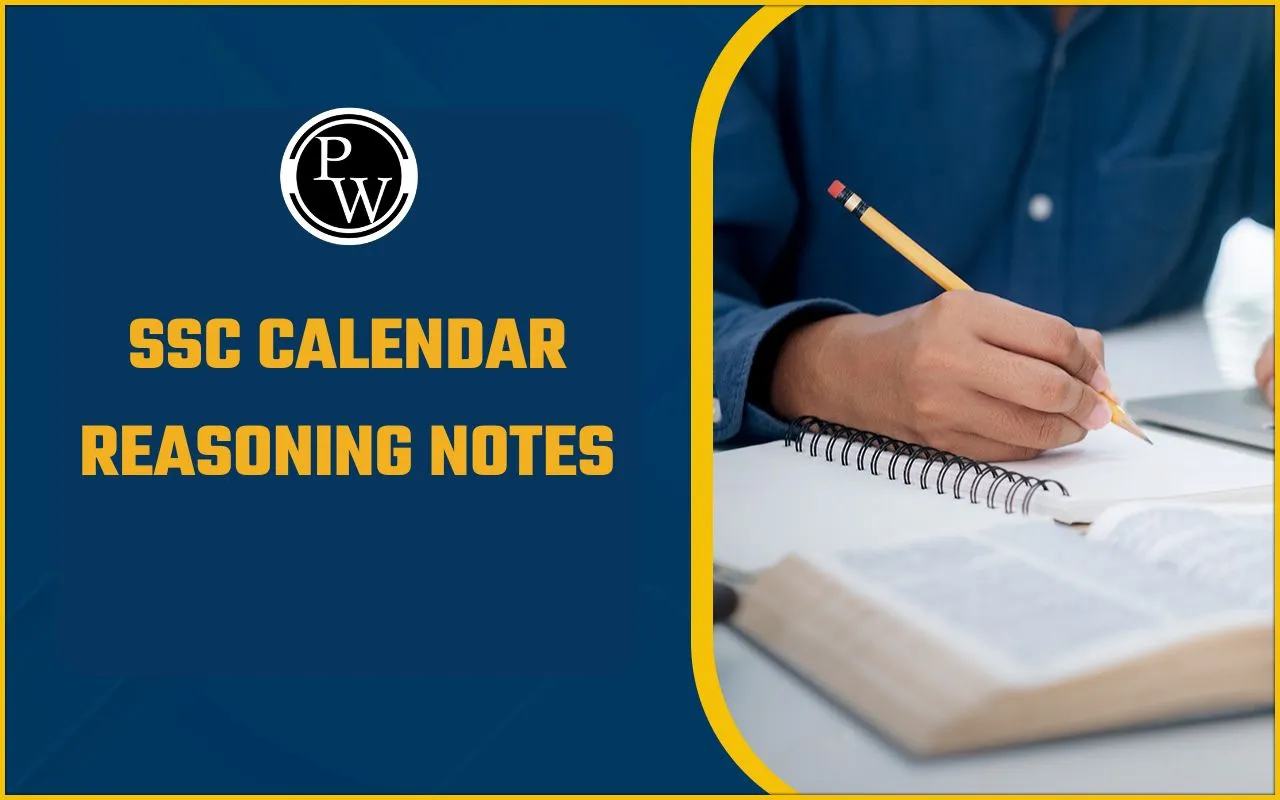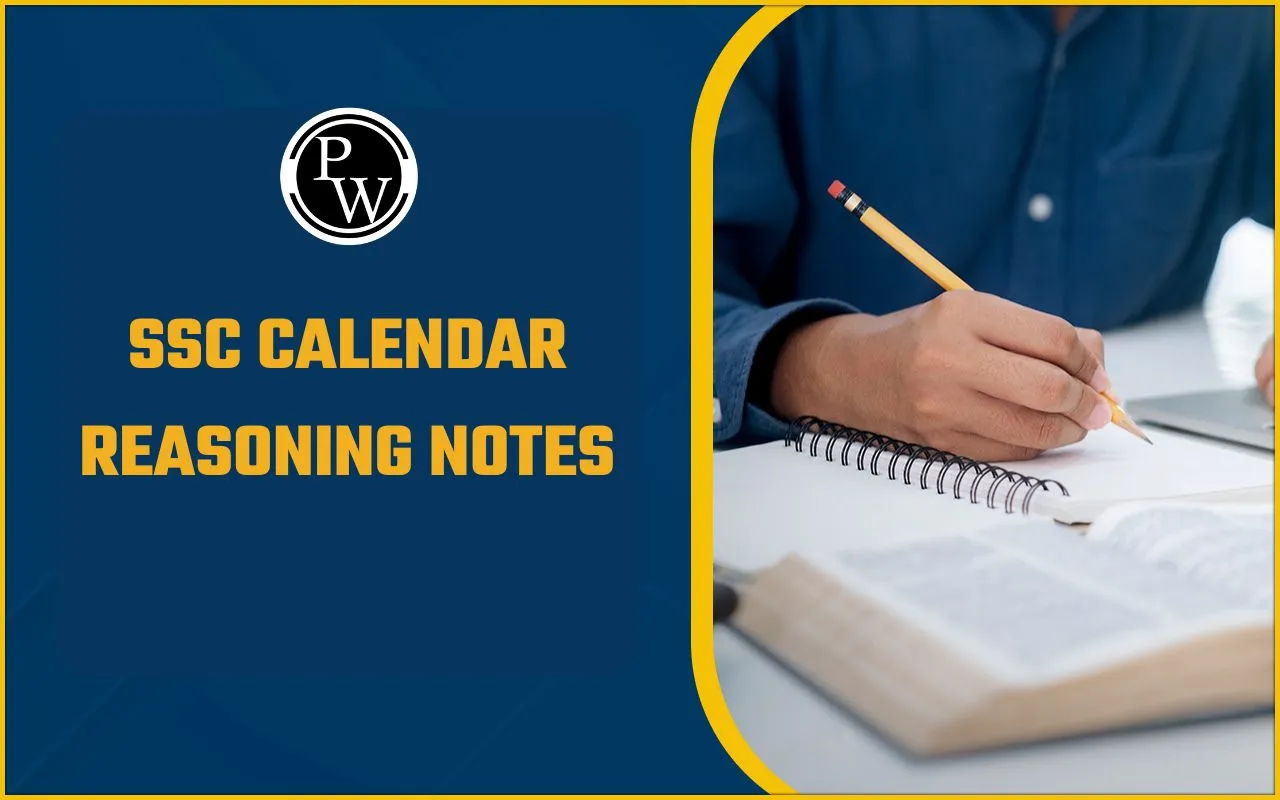

SSC Calendar Reasoning Notes are available in PDF format in both Hindi and English. They are useful for aspirants preparing for competitive exams like SSC CGL, SSC CHSL, and SSC MTS.
Calendar reasoning is one of the most commonly asked topics in the reasoning section. It tests a candidate’s ability to calculate days, dates, odd days, leap years, and recurring patterns. These calendar reasoning notes for SSC simplify concepts through clear explanations, step-by-step tricks, and solved examples.
SSC Calendar Reasoning Notes
SSC Calendar Reasoning Notes offer a detailed explanation of all fundamental and advanced concepts related to calendar problems.
Example 1: Which of the following is a leap year?
(a) 2100
(b) 1700
(c) 1600
(d) 1300
Solution (c): The correct answer is (c) 1600. This is because 1600 is divisible by 4 and 400, which makes it a leap year. The other options are not leap years because they are divisible by 4 and but not by 400. This is an exception to the rule that every year divisible by 4 is a leap year. Therefore, the required answer is 1600.
Example 2: Which of the following is not a leap year?
(a) 1980
(b) 1688
(c) 1760
(d) 1842
Solution (d): The correct answer is (d) 1842. This is because 1842 is not divisible by 4, which makes it a regular year according to the rules. The other options are leap years because they are divisible by 4. Therefore, the required answer is 1842.
Example 3: Which of the day will not be the last day of any century year?
(a) Friday
(b) Sunday
(c) Monday
(d) Tuesday
Solution (d): As per the question, the number of odd days in century years is as follows:
(i) 100 Years = 5 odd days, so, the last day is Friday.
(ii) 200 Years = 3 odd days, so, the last day is Wednesday.
(iii) 300 Years = 1 odd day, so, the last day is Monday.
(iv) 400 Years = 0 odd days, so, the last day is Sunday.
So, the last day of the century year will not be Tuesday. Therefore, the required day is Tuesday.
Example 4: Which of the following is the first day of the 400th century?
(a) Monday
(b) Wednesday
(c) Tuesday
(d) Sunday
Solution (c): As per the question, the number of odd days in century years is as follows:
(i) 100 Years = 5 odd days, so, the last day is Friday.
(ii) 200 Years = 3 odd days, so, the last day is Wednesday.
(iii) 300 Years = 1 odd day, so, the last day is Monday.
(iv) 400 Years = 0 odd days, so, the last day is Sunday.
So, the first day of the 400 century will be Monday + 1 = Tuesday. Therefore, the required day is Tuesday.
SSC Calendar Reasoning Notes Key Features
These notes include formulas, examples, and calendar reasoning shortcuts for SSC.
-
It includes important SSC calendar reasoning formulas with simple explanations for faster understanding.
-
It demonstrates how each formula is applied using real exam-style SSC calendar reasoning questions.
-
Each topic includes calendar reasoning practice questions for SSC to test knowledge immediately.
-
They are aligned with the calendar reasoning for the SSC CHSL syllabus. This ensures that every important pattern is covered.
-
The SSC reasoning calendar topic PDF download allows offline study and quick revision.
SSC Calendar Reasoning Notes PDF
SSC Calendar Reasoning Notes PDF provides a comprehensive understanding of all calendar-related reasoning questions. Each PDF includes step-by-step explanations, calendar reasoning formulas, and practice questions.
These calendar reasoning for SSC CGL and CHSL include shortcuts, tricks, and previous year question patterns as well. The PDF is available in both Hindi and English for clarity of concepts.
|
SSC Calendar Reasoning Notes PDF |
|
|
SSC Calendar Reasoning Notes PDF (English) |
|
|
SSC Calendar Reasoning Notes PDF (Hindi) |
|
Benefits of SSC Calendar Reasoning Notes
Studying from the SSC Calendar Reasoning Notes will help you understand theory as well as sharpen analytical thinking and improve exam performance. Below are the benefits of using SSC Calendar reasoning notes:
-
It builds a deep understanding of calendar logic, day calculation, and leap year handling.
-
Using calendar reasoning shortcuts for SSC, you can solve questions in seconds instead of minutes.
-
Step-by-step examples and clear formulas reduce the chances of silly mistakes while answering SSC calendar reasoning questions.
-
Repeated practice with SSC MTS calendar reasoning notes will help you retain the logic behind every type of calendar problem.
-
These calendar reasoning notes for SSC CHSL are useful for SSC CGL, SSC CHSL, SSC MTS, and other reasoning-based government exams.
How to Use SSC Calendar Reasoning Notes
SSC Calendar Reasoning Notes are most effective when used strategically. Instead of memorizing formulas, focus on understanding and practicing regularly. Follow these steps to prepare well:
-
Begin with the concept of odd days and leap years to build a strong foundation. Understand the logic rather than just remembering outcomes.
-
Study each SSC calendar reasoning formula step by step. Try deriving it through examples to ensure long-term retention.
-
Solve calendar reasoning practice questions for SSC after every sub-topic to apply what you’ve learned immediately.
-
Memorize calendar reasoning tricks for SSC only after grasping the underlying logic. This prevents confusion during exams.
-
Attempt topic-wise quizzes or previous year papers using a timer to build speed and accuracy.
-
Before the exam, revise the formulas, key patterns, and exceptions (like century years or non-leap year cases) from the PDF notes.
SSC Calendar Reasoning Practice Tips
Practicing calendar reasoning requires pattern recognition and logical application. These tips help you make your practice more effective:
-
Understand how odd days accumulate over months and years, as this forms the base of most calendar problems.
-
Try finding the day for your birthdate or historical events. This makes learning engaging and memorable.
-
SSC MTS calendar reasoning notes include both forward and backward date questions to improve adaptability.
-
The more you apply SSC calendar reasoning formulas, the more naturally they’ll come during the exam.
-
Evaluate your accuracy and speed through SSC reasoning practice sets.
